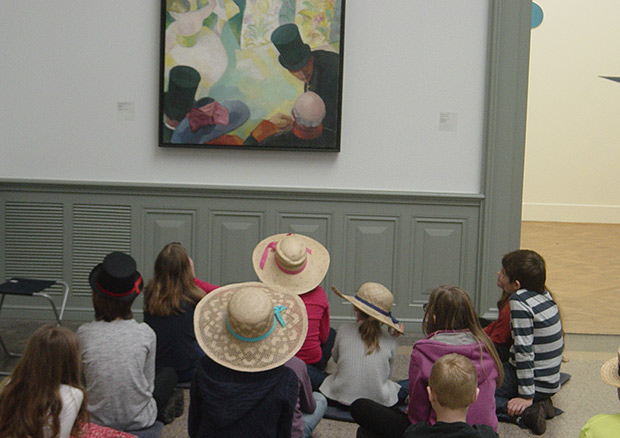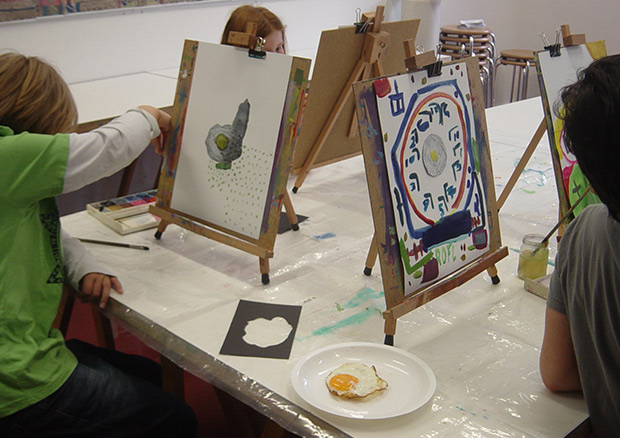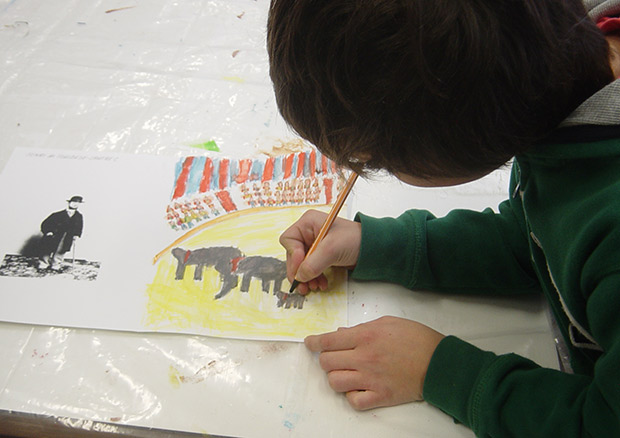Cool Kids’ Classes: Why art appreciation is “cool”
Give a child a crayon and he’ll draw. Provide the child with space, materials and the opportunity and he’ll (or she’ll) create. Add to the mix the unique resource of hundreds of years of paintings, drawings and sculptures by internationally renown artists and he’ll feel inspired and self-empowered.
Art encourages a child’s creative self-expression. In combination with art appreciation held in the setting of the galleries at Berne’s Museum of Fine Arts before the originals, the child learns to see and to communicate his thoughts. This may be verbal, in describing his thoughts to others, or non-verbal as in acting-out a sculpture or a scene in a painting. Supply the appropriate costume or prop and the motivation is a given.

Joining the audience at Louis Moilliet’s Music Hall
Since 1988 our art workshops for English-speaking youngsters (Cool Kids’ Classes) have encouraged kids and teens to participate actively in the world of the art museum–learning about its collection and special exhibitions, experimenting in the art studio with various media, materials, techniques, genres and styles, as well as acquiring the terminology of art. In all these years I have yet to see a child leave our workshop without a smile, a sense of accomplishment or at the very least a thoughtful expression.
The multi-sensory approach allows the children to do some deductive reasoning and detective work to find an artwork using clues. Blindfolded, listening to the crack of and feeling the shape and texture of an egg, then armed with a magnifying glass led 15-20 children to a Salvador Dali painting of a fried egg floating above a landscape. Discovering the discrepancy of this concrete imagery reinforced the youngsters’ ability to think independently–some children suggesting that perhaps Dali had painted a dream in which various absurd images might appear together. They then began to use free association–quickly spewing forth an array of words without much conscious thought. How easily they began to comprehend one of the concepts of Surrealism and how interested they were in comparing this painting to some of Dali’s other compositions, besides learning about the artist.
Back in the art studio, inspired by Dali’s work along with a real fried egg, the children at their easels experimented with a painted collage, metamorphosing their own fried eggs into a sun, a face, a clock.

Morphing an egg into a clockface…
A further example: to the bemusement of some museum visitors, I laid down animal tracks one morning, leading from the studio to one of the galleries in which Henri Rousseau’s painting “ The Tiger Hunt “ was displayed.
The children followed the tracks after first determining what kind of animal footprint it could be, which then led them to the gallery where the tracks ended near other works which included various animals. To make Rousseau’s painting come to life once the work was found, the workshop participants sounded off a variety of Orff musical instruments to simulate the chirping of birds, the pit-pattering of rain, the clap of thunder—in short, the tiger’s landscape domain.
In a recent Toulouse Lautrec workshop we used another interdisciplinary approach after observing and discussing Lautrec’s circus scenes. Laying a gymnastics mat on the floor, several talented kids and teens demonstrated their acrobatic and ballet skills. The creative follow-up activity was then to watercolor their own circus performers.

Inspired by Toulouse-Lautrec’s circus drawings
Upon heading down the stairs I overheard one of our young art connoisseurs exclaim : «I love, love, love this ! »
The attest to the long standing success of the workshop program can be confirmed by the fact that a large number of youngsters attend each class, year after year, as both the Saturday morning class and the Tuesday afternoon after-school classes are usually booked out.
It has been my pleasure to introduce such cool kids into the cool world of art at Bern’s Kunstmuseum.
See all the dates for the Cool Kids’ Classes in 2016.
Veröffentlicht unter Allgemein, Events
Schlagwörter: Kinder, Kunstvermittlung

